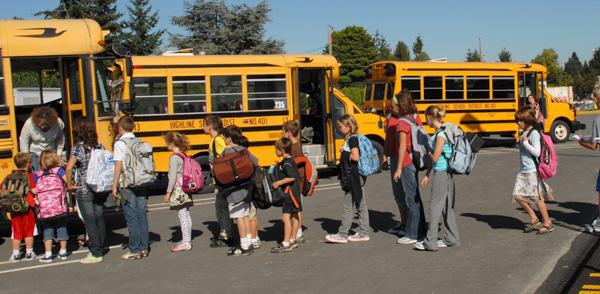$152,000 in cab fare for Highline homeless students
Students line up to board buses after school. In addition to busing students within the district, Highline must provide transportation to homeless students who have moved out of the district.
Fri, 09/11/2009
Before the new school year, school districts routinely dissect their budgets. Where are the high costs that could be mitigated? Are there programs that don't pencil out? Are there revenue sources that should be pursued?
In this economic climate, Highline is taking a look at a little-known provision of federal law, one that requires that district students who leave the district because of homelessness are able to continue to attend the district afterwards.
And Highline must provide them transportation.
The requirement is part of the McKinney-Vento Homeless Assistance Act, a 1987 federal law that ensures educational rights and protections for children and youth experiencing homelessness.
Last year, Highline spent $383,815 on transporting 337 kids into the district after they became homeless.
The district uses Metro buses, special buses, paid drivers, and even a taxi. They paid $152,000 alone in cab fare to transport 33 kids into the district during the year.
Those costs do not even include the cost of tracking and staffing the program at the district level. The state Office of the Superintendent of Public Instruction does reimburse districts for the costs, but it only partially covers the bill. Last year the district received a little more than $77,000 to cover the program, with a net loss of over $300,000.
Highline School Board member Julie Burr Spani said one solution is for Highline to bill the district where the kids now live, or get half the costs back from that district.
"I understand the intent of the law," she said. "If kids are homeless, the one thing that should be stable in their lives is school. But we are at a place when we are looking at every cost, and this is a big one."
Catherine Carbone Rogers, spokeswoman for Highline, said the district is considering sending letters to the Congressional delegation, asking them to look at the law.
If the law doesn't change, she said, the district wants to pursue reimbursement to meet the law's requirements.
"We are not compensated for this," she said. "Does the law need to be looked at? We are cutting music, sports, teachers.
"This is not that we don't care about the homeless kids. But is it really helping them to have them brought into the district after they have moved on?"
Added Burr Spani, "We will always have homeless kids in our district. We care about all students in our district. We want them in school because that is their way out of poverty.
"But a lot of things are done because that's the way they have always been. It's not necessarily the best solution. It's costly."
Melinda Dyer is the program supervisor at the state Office of the Superintendent of Public Instruction for Education of Homeless Children and Youth. She said the fact is that districts are struggling financially, and she has heard others raise the concern about McKinney-Vento.
"During these times, districts are scrutinizing everything," she said. "We have seen more districts with questions about the costs of transporting homeless children.
"The reality is that the program is underfunded. It is not unfunded. The district receives some funding, but we know they want more."
The American Association of School Administrators has weighed in with concern, saying Congress has provided little money to meet the law's intent.
Dyer said the law originally came about because kids have a right to be in school, attending where they have always attended, whether they move or not.
She said there is plenty of research that shows those kids that stay in their home school will be more successful. Coming to school, and staying in school, she said, is half the battle.
"In this economic period, families we have never seen struggle, are losing housing, employment, health care," she said. "School districts are seeing an influx in families that need services. The needs are greater and the stakes are higher. We have more kids in jeopardy."
Research shows the recession has caused a sharp spike in homeless youth nationwide. The number of schoolchildren in homeless families appears to have risen by 75 percent to 100 percent in many districts over the last two years, according to the National Association for the Education of Homeless Children and Youth.
Dyer said the McKinney-Vento Act was originally intended to provide a voice for kids who don't have one.
"I think the districts should advocate for more funding to pay for this transportation," she said. "It is a critical gap. But just as critical is education for these kids. They need all the support they can get. The intent of the law is sound."
U.S Senator Patty Murray is a national leader on homeless education, and a staunch supporter of McKinney-Vento.
"She has worked tirelessly on this issue," Dyer said. "I think the district probably needs to talk to her."
The district says it is just beginning to look at the issue, and may write a letter to Murray and the rest of the delegation, starting a conversation on the law and its costs, or perhaps looking at the federal funding of the law.
"We want to see if this is truly the best way to make sure homeless kids succeed," said Highline's Burr Spani. "If it is, we want to look at getting reimbursement to match the cost of the law. It's really pretty simple."


